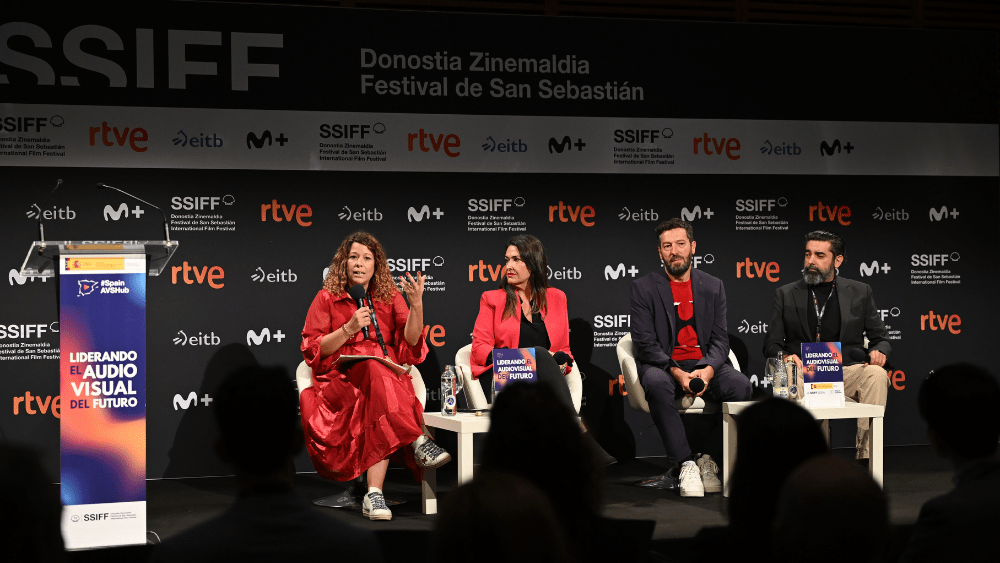Top executives, government leaders and international figures gathered at the San Sebastian Film Festival this Sunday to look back at Spain’s position within the European audiovisual industry and how to navigate the ever-evolving market.
The third edition, titled “Audiovisuality of the Future,” is being held by Spain’s Ministry of Digital Transformation and Public Services through the State Secretariat for Digitalization and Artificial Intelligence. The rally aims to look back at the audiovisual landscape of Europe and understand how Spanish experts can thrive in an industry that is constantly facing major changes. This year, the conversation focused primarily on two important issues. When it comes to artificial intelligence and protecting Spanish IP, there is Spain’s need for better regulations.
In her closing remarks, Secretary of State for Digitalization and Artificial Intelligence, Maria Gonzalez Veracruz, said that holding the third year of conference felt like “spatial integration.” “The work of everyone in this room is extremely important to Spain as the least successful non-English audiovisual content producer in Europe,” she added. “More than anything, we’re continuing to invest. This is an integration moment. It’s hard to understand new tools, but what we’re doing is very powerful.”
“It is essential to bet on having Spain as a bridge between Europe and Latin America, to strengthen creative, technical and productive talent at the national level.”
“We must become increasingly involved in international projects and collaborative productions,” he repeated. “I think this is an element that can give us a qualitative international leap and give us fame and important recognition. But we have to be accompanied by European allies to compete with other markets. We are committed to opening markets that include countries on the Asian continent.”
It is important to note that the conference took place just an hour after the European Producers Club (EPC) shared a statement highlighting concerns about the recently proposed Agoraeu regulations (2028-2034). The European Union programme is proposed by the European Commission to support and promote culture and media. According to the EPC, “The new media strand raises serious concerns about the future of independent European audiovisual creation.”
Key concerns include “weak support for independent production: removal of independence standards, unclear budgets and priorities, open doors to non-European entities, and complex and opaque governance.” The general boundaries between these concerns are the threat to cultural sovereignty and the increase in the status of dominats in US streamers. Although the EPC statement was not addressed directly during the meeting, these issues were widely discussed, particularly regarding cultural uniformity, increasingly digital behavior among young audiences, and the spread of foreign-developed AI programs.
Below are some of the major takeaways for this year’s lead The Audiovisuual of The Future Conference.
AI: not creating jobs and replacing them
As expected, AI dominated much of the conversation in the meeting. On a panel on new trends in the audiovisual sector, CEO of Octopus AI Laboratory Carlos Fernándezdevigo tried to soothe some of his worries by highlighting the potential of artificial intelligence in the industry. “Thanks to AI, there are currently viable projects that weren’t feasible just a few years ago,” he reiterated, saying that AI allows for the creation of new business models and “thus enabling the creation of new jobs.”
“Without technology, there’s no film,” said Natalie Martinez, president of the Spanish Association of Animation and Visual Effects Producers (DIBOOS). “We haven’t just discovered AI. We’ve been using it for years, even if they were in pre-primitive forms. We’re using it as a tool. We want to emphasize that it’s a tool and that the tool doesn’t replace anyone who works on those tools.”
Not in cultural homogenization
When talking about the great fear that comes from technologies such as AI, Martínez warned that it is necessary to bear in mind how technologies developed and defended by other countries can contribute to cultural homogenization. “What we create should represent us,” she said. “We should have an original story. For me, that’s our biggest obstacle.”
Lucía Recalde, head of the European Commission’s Creative Media Unit, gave a brief presentation of the recently completed media outlook report for 2025. The new report showed that younger audiences are increasingly focused on digital platforms. “And we know they’re not Europe,” she emphasized. She highlighted before showing numbers that highlight that 70% of the Spanish market is made up of non-European players such as Netflix, Disney and Amazon Prime Video. “The weight of American companies grew last year, but European companies fell,” she warned.
Spain’s IP belongs to Spain
Perhaps the most praised passage of the entire conference, Alfonso Blanco, president of Galician audiovisual clusters, has repeatedly stated that the most pressing issue in the Spanish industry today is creative rights preservation. “We need laws to protect our creators and our products,” he said. Other major European powers, such as France and the UK, have long established regulations that provide creative security regarding the original IP, and Spain still lacks that sense of security. “We need to regulate the television market,” added Blanco. “We are one of the biggest challenges in maintaining IP rights. The system is at fault.”
Culture Cap7 director Alfonso Del Río repeated this idea. Rights retention is an important point of funding Del Rio’s conversations, which often work with international partners. The executive said, “We’re beginning to go to international studios and see fundraising methods that say they have ideas, but we have the ability to assume risk, so we want to make it ours.” However, Del Rio has repeatedly said that having to play with such a high interest should not take priority over Spanish IP laws.
Talent not enough: control at home and internationally
José Antonio de Luna, co-founder of Filmin, said players feel that they are “always focusing on all their strategies on ingredients.”
Recalde highlighted how research shows that “European films have not travelled enough to other countries.” Currently, only 44% of European films travel internationally. US domination is also a problem in the Spanish domestic exhibition market, with US films accounting for 20% of offers and 60% of box office revenue, while European films accounting for 60% of offers and only 31% of box office revenue.
What is the European model?
Speaking about the importance and difficulties of co-production with other European countries, Derna noted that Spain “has completely lacked the idea of a European model, but also lacked the tools of how to think about it.”
Helena Suárez Jaqueti, a partner at the law firm ECIJA and founder of E-LAB, praised the co-production model as a way to expose Spanish experts to international expertise without requiring them to leave Spain, but it is a “pretty difficult process” as different European Unions have different legal guidelines for co-production. “Each law needs to be taken into consideration. It’s difficult if it’s a European platform that wants to reach some markets.”
Clara Ruipérez, director of legal content strategy for Movistar Plus+, stressed that although films have seen an increase in co-production in recent years, models are still quite difficult to make on television. “We’re always looking to be open to (co-producing), but that’s not the reality. There’s still a lot of (models) missing.”

